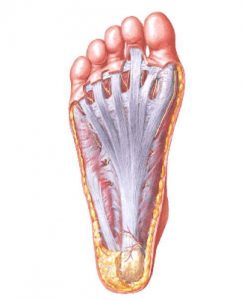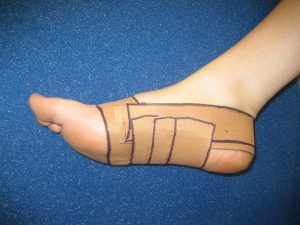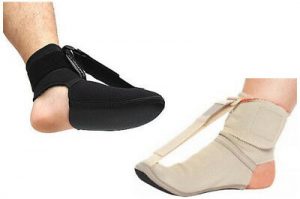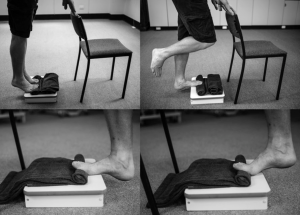July 4 2019
Plantar fasciitis is one of the most annoying pains to get! At its worst sufferers’ shudder at the thought of putting their feet on the ground first thing in the morning. A sharp shooting pain like standing on a bunch of pins is how it has been described to us by one patient and this certainly isn’t a fun way to progress through the day.
The most recent statistics suggest that plantar fasciitis accounts for between 11% – 15% of all foot problems that require health professionals within adult populations. It is also suggested that 1 in 10 adults will suffer from the condition at some stage in our lives. Hopefully if you count your 9 closest friends one of them has had it or it could be you ……. !!!
There are a number of different treatments options and some of them are effective and others have proven to be less so. So put your feet up, they are probably sore after all, and let us take you through the latest in plantar fasciitis management.
Terminology
Firstly, the term plantar fasciitis is beginning to be on the nose! The suffix “itis” suggests inflammation is at the core of the condition. Recent research suggests that whilst there is inflammation present in the area of the plantar fascia it is not necessarily the main driver of the pain. It is now also known that the plantar fascia is not the only source of pain in this condition. As a result, the term plantar heel pain is now being used as the new umbrella term. Suppose we should stop saying it from now on then ….
Structure
The plantar fascia is a band of … fascia (fancy name for a connective tissue) that attaches from the underside of your calcaneus (heel bone) and runs along the bottom of your foot and ends at the base of your toes on your metatarsals. It’s main role is to provide structural support for the foot for walking, running and all the other things we subject our feet to. The photo below shows the underside of your foot and how the plantar fascia connects and spreads across the foot to give it postural support.

Interestingly, the plantar fascia has connections that run from the Achilles tendon and blend into it. This has some big implications for how to manage the condition, but more on that later.
Type of tissue
Plantar fascia is what is called an aponeurosis or a connective tissue and as such doesn’t have the ability to contract. As a result the treatment for this condition is slightly different to rehabilitating other tissues and structures.
Who Gets It?
Plantar heel pain is characterised as pain on the inside of the supporting surface of the heel bone that increases after periods of inactivity including sitting for a while or sleeping. The pain is generally worsened with weight bearing activities. It is most common in females (sorry ladies!) between 40 – 60 years of age but is also common in highly active people. Over time people who suffer from plantar heel pain end up reducing their participation in exercise and also find it difficult to undertake daily living tasks.
Most cases resolve in under 12 months but the daily pain of this condition has driven a lot of money into researching effective treatments that can resolve this common problem quicker.
Current Treatments
The current treatments, some of which are shown in photos below, include footwear modification, various forms of taping, stretching exercises, anti-inflammatory medications and even cortisone injections and shock-wave therapy.



At various times each of these interventions can be effective for short term pain relief but there is still limited high quality research evidence to suggest that any of these interventions alone are effective cures.
Having said that, making sure you have the right footwear for the daily activities and exercise you are doing is important. Getting this right can prevent flare ups of foot pain and our Podiatry guru Craig Douglass is more than happy to see you if this is a factor in your presenting complaint. Read more on Craig on his bio here.
New Concepts – Treat It Like a Tendon
One of the areas of great research to date is in the tendon space. For tendon injuries, high load (heavy) strength training is gradually introduced as the most effective treatment to overcome tendon pain. One research group has been researching the use of this same type of concept in plantar heel pain and has had some excellent results.
The participants were instructed to do some simple calf strength work, as illustrated in the picture below. The idea was to gradually decrease the number of repetitions and increase the weight via backpacks filled with weights or books!!

Over a 12 week period the participants had excellent results with huge improvements in pain and function. There is still a way to go with this research but the early thinking is that the high loading with slow repetitions could stimulate the collagen (building blocks of the fascia) to tolerate loading better and reduce pain. The connection between the Achilles tendon and the plantar fascia we mentioned before may also be a factor as this type of exercise builds up your tolerance and strength in your calf and Achilles tendon and this may unload the plantar fascia and allow it to settle down.
Bang For Your Buck
So what do you choose to do. The best evidence to date suggests trying to offload the plantar fascia for a short period of time and trying some of the current treatments such as changing shoes, stretching and icing for short term pain relief. Following that, a gradual return to activity and some heavy strength training could be where the secret to the cure lies.
This condition is very debilitating and early advice can save you a lot of pain. We would love to take a look at you and help you along the way. Don’t put up with plantar heel pain.
Put your foot down … get strong and get back on your feet sooner!



